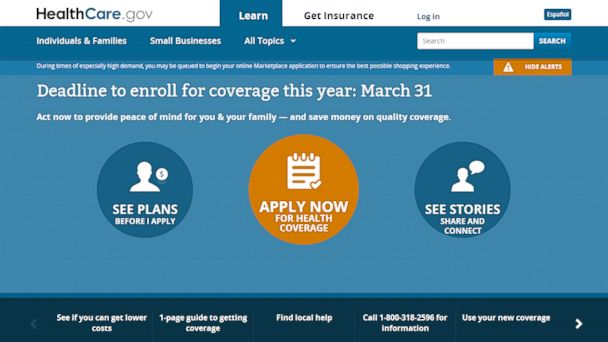Obamacare Deadline Extended, but Should You Wait?

(Photo Credit: HealthCare.gov)
President Obama insisted last month that Monday, March 31, would be "last call" for Americans to sign up for a health insurance plan under the federal law without risking a financial penalty. Like so many other deadlines involving the Affordable Care Act, however, this one turned out to be flexible.
The White House effectively extended the open enrollment period Tuesday by allowing anyone who claims to have started the enrollment process on or before March 31 to check a "special enrollment" box. Doing so grants the applicant a hardship exemption and gives them a yet-to-be-determined grace period to complete the enrollment process. The deadline to submit paper applications was also extended to a final-for-now date of April 7.
RELATED: Boehner on Obamacare Delays
As a Kaiser Health Tracking Poll released this week found, some Americans won't be signing up for health insurance no matter how long they are given. Half of adults younger than 65 who still lack coverage intend to remain without insurance.
Of the uninsured, two out of three said they have not tried to get coverage. Only four in 10 of the uninsured were even aware of the March 31 deadline to sign up for coverage, Kaiser reported.
But is it really a good idea to forgo health insurance and risk the penalty? A new analysis released today by the data-tracking group NerdWallet suggests this might be an expensive strategy.
The maximum penalty for an individual who decides to go without health insurance is $95 a year, or 1 percent of total income, whichever is higher. But, as the NerdWallet report noted, the maximum penalty is slated to go up every year. The maximum penalty jumps to $325 next year and, assuming a 2 percent rate of yearly inflation, NerdWallet estimates the penalty will balloon to $752.29 by the year 2020.
The report estimated the cost of a lifetime of penalties - for someone who is dropped from their parent's policy at age 27 and decides never to purchase health insurance until they reach Medicare eligibility at the age of 65 - to be a minimum of $36,556 for an individual and $109,668 for a family of four. Higher income earners may pay a lot more, possibly thousands more than they would have paid for insurance, the report said.
Even without factoring in penalties, several recent reports indicate that medical care costs might pose a huge financial burden for many uninsured Americans.
For example, another NerdWallet report released earlier in the year that factored national data from several major studies found that the average cost of standard preventative care for a woman, including a gynecological visit, contraception and recommended yearly tests, totaled $1,231, about $150 higher than the average cost of premiums for a bronze level plan.
The report also noted that such services are included free of charge in any Obamacare compliant policy.
According to another recent study published in the journal Plos One, the average cost of an emergency room visit for a young, uninsured person is $1,674, also a higher amount than the average yearly premiums for a bronze level plan for someone in that age group. And data released by the certified health insurance site GetInsured found that even if you're a young adult between the ages of 25 and 34, you still have a 1 in 10 chance of racking up at least $13,000 worth of medical bills this year.
RELATED: Supreme Court Considers Contraception Mandate
Senior policy analyst Ivan Williams of GetInsured said that depending on how long the extension lasts, it could provide an unintended end-run around the penalty because anyone can check the exemption box without providing proof. But any American who goes without insurance would still be vulnerable to unexpected medical expenses, he said.
RELATED: Obamacare Turns 4